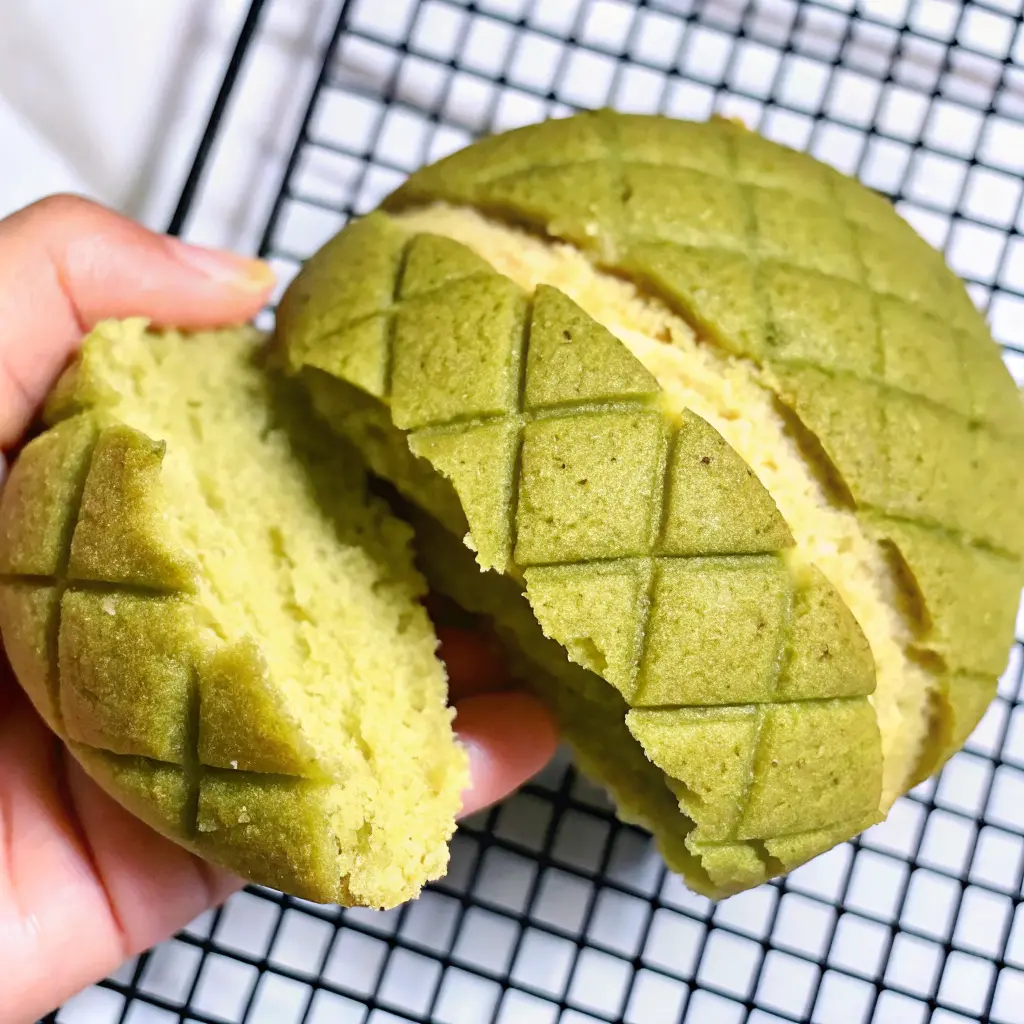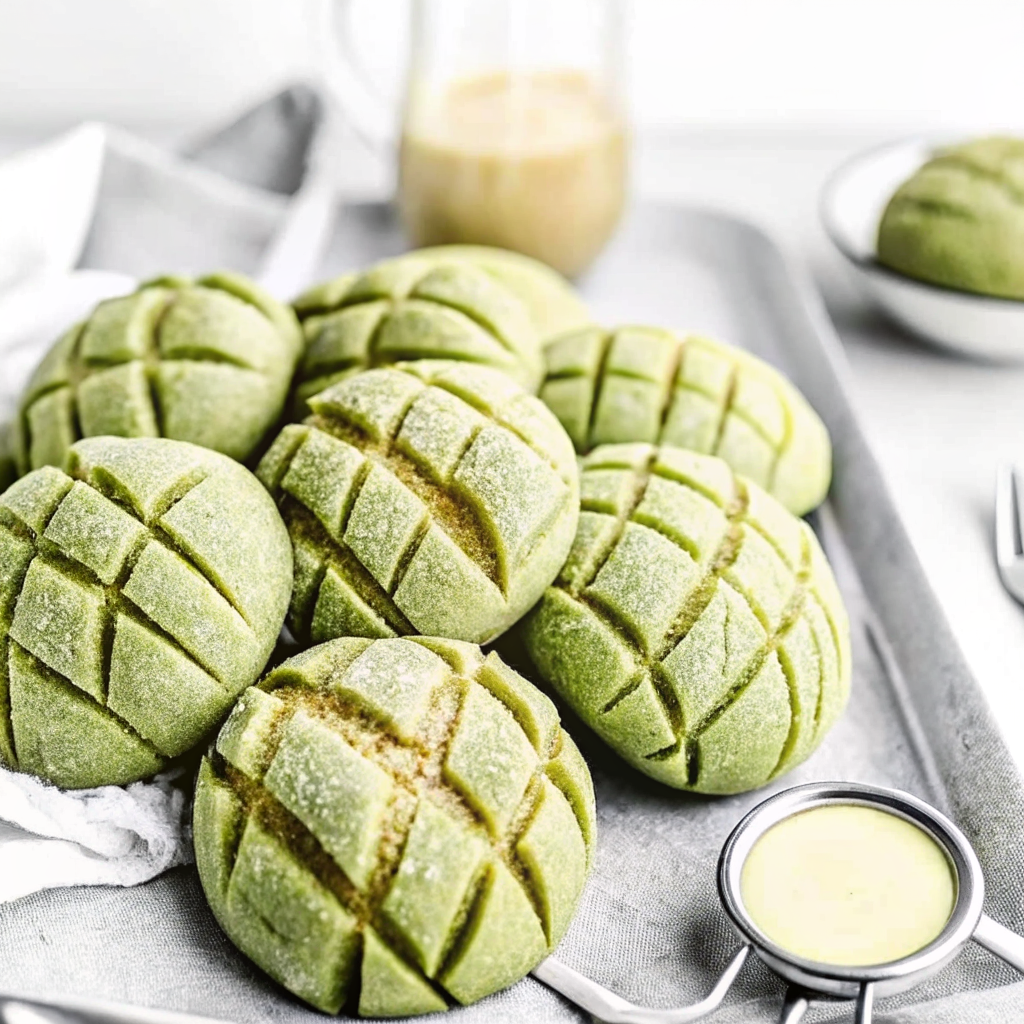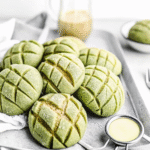Matcha Pan brings together the soft, airy texture of Japanese milk bread and the earthy, vibrant flavor of ceremonial green tea powder. Whether you’re a matcha lover or just love making bread from scratch, this recipe is the perfect balance of tradition and modern comfort. In this guide, you’ll learn exactly what Matcha Pan is, why it’s so irresistible, and how to make it at home with easy-to-follow steps.
If you’ve never tried making matcha-flavored bread before, now’s the time to roll up your sleeves. Not only is this bread stunning in appearance with its bright green swirl, but it also makes for a satisfying breakfast, snack, or gift-worthy bake.
Table of Contents
What Is Matcha Pan?
The Meaning Behind the Name
Pan means “bread” in Japanese (borrowed from Portuguese), and matcha refers to finely ground green tea powder used in traditional Japanese tea ceremonies. So, Matcha Pan literally means “matcha bread.” This isn’t your average loaf—it’s a soft, pillowy bread infused with earthy matcha and sometimes filled with sweet bean paste or white chocolate.
More Than Just Bread
Matcha Pan is more than a flavored carb—it’s a cultural fusion. It combines the art of Japanese baking with the rich history of green tea. Often found in Japanese bakeries, it’s become a trendy and delicious way to enjoy matcha in a new form.
PrintHomemade Matcha Pan: Soft, Fluffy, and Full of Flavor
A soft, airy Japanese milk bread swirled with earthy ceremonial-grade matcha. Perfect for breakfast, tea time, or gifting.
- Prep Time: 30 minutes
- Cook Time: 30 minutes
- Total Time: 3 hours
- Yield: 1 loaf 1x
- Category: Bread
- Method: Baking
- Cuisine: Japanese
Ingredients
- 2 ½ cups bread flour
- 2 tbsp sugar
- 1 tsp salt
- 2 tsp instant yeast
- ¾ cup whole milk (warm)
- 2 tbsp unsalted butter (softened)
- 2 tbsp milk powder (optional)
- For the Tangzhong: 2 tbsp bread flour, ½ cup water
- For the Matcha Mixture: 1 tbsp matcha powder, 1 tsp sugar, 1–2 tsp warm water
Instructions
- In a small saucepan, whisk 2 tbsp flour with ½ cup water. Cook over medium heat, stirring until thickened like pudding. Let cool.
- In a large bowl, mix flour, sugar, milk powder, salt. Add yeast, warm milk, and the cooled tangzhong. Mix into a shaggy dough.
- Add softened butter and knead until smooth and elastic (about 10 minutes by hand or mixer).
- Split dough in half. Mix matcha paste (matcha + sugar + water) into one half. Knead until evenly green.
- Place each dough in separate bowls, cover, and let rise 1 hour or until doubled.
- Roll both doughs into equal rectangles. Stack, roll tightly into a log, and place in a greased loaf pan.
- Cover and proof again for 40–60 minutes, until dough reaches pan top.
- Preheat oven to 350°F (175°C). Bake 25–30 minutes until golden.
- Cool on wire rack before slicing. Serve warm or toasted.
Notes
Use fresh, high-quality matcha for best color and flavor. Don’t skip the tangzhong step—it’s the key to that soft, cloud-like texture.
Nutrition
- Serving Size: 1 slice
- Calories: 170
- Sugar: 3g
- Sodium: 180mg
- Fat: 5g
- Saturated Fat: 3g
- Unsaturated Fat: 2g
- Trans Fat: 0g
- Carbohydrates: 26g
- Fiber: 1g
- Protein: 5g
- Cholesterol: 15mg
Why You’ll Love This Recipe
1. Perfectly Soft and Airy Texture
Using Japanese milk bread techniques, like tangzhong (a water-roux method), this bread bakes up incredibly fluffy and light. It’s the kind of loaf you pull apart with your hands and marvel at its stretchy, cloud-like interior.
2. Subtle Sweetness with a Matcha Kick
The slightly bitter edge of matcha balances beautifully with the soft sweetness of the dough. You get flavor complexity without the need for heavy fillings or frostings.
3. Stunning Visual Appeal
The natural green hue of matcha makes every slice eye-catching—great for brunch, Instagram, or afternoon tea.
4. It’s a Fun, Impressive Bake
Whether you’re a beginner or a seasoned baker, there’s something satisfying about kneading, proofing, and shaping Matcha Pan. It’s the kind of project that feels as rewarding as it is delicious.
Ingredients You’ll Need
For the Dough
- 2 ½ cups bread flour
- 2 tbsp sugar
- 1 tsp salt
- 2 tsp instant yeast
- ¾ cup whole milk (warm)
- 2 tbsp unsalted butter (softened)
- 2 tbsp milk powder (optional for extra softness)
For the Tangzhong (Water-Roux)
- 2 tbsp bread flour
- ½ cup water
For the Matcha Mixture
- 1 tbsp matcha powder (culinary or ceremonial grade)
- 1 tsp sugar
- 1–2 tsp warm water
Tip: Use high-quality matcha powder for deeper color and flavor.

How to Make Matcha Pan (Step-by-Step)
1. Make the Tangzhong
In a small saucepan, whisk 2 tbsp flour with ½ cup water. Cook over medium heat, stirring constantly until it thickens to a pudding-like paste. Let it cool.
2. Prepare the Dough
In a large bowl, combine flour, sugar, milk powder, and salt. Add yeast, warm milk, and the cooled tangzhong. Mix to form a shaggy dough. Add softened butter and knead until smooth and elastic (about 10 minutes by hand or stand mixer).
3. Divide and Color the Dough
Split the dough in half. In one half, mix the prepared matcha paste (matcha + sugar + water) and knead until evenly green. You’ll now have one plain dough and one matcha dough.
4. First Proof
Place each dough in separate bowls, cover, and let rise in a warm place for 1 hour or until doubled.
5. Shape the Loaf
Roll out both doughs into equal-sized rectangles. Stack one on top of the other and roll tightly into a log. Place into a greased loaf pan.
6. Final Proof
Cover and let the shaped loaf rise again for about 40–60 minutes, or until the dough reaches the top of the pan.
7. Bake
Preheat the oven to 350°F (175°C). Bake the Matcha Pan for 25–30 minutes until golden on top and cooked through.
8. Cool and Slice
Remove from the pan and cool on a wire rack before slicing. Enjoy warm or toasted!
Emily’s Matcha Baking Tips
Emily’s Discovery of Matcha Pan
Emily, a food blogger and matcha fanatic from Oregon, first tasted Matcha Pan at a bakery in Kyoto. Inspired by its gentle sweetness and pillowy texture, she set out to create her own version at home. After a few floury messes and under-proofed loaves, she nailed the method—and now, Matcha Pan is a weekend ritual in her kitchen.
Emily’s Best Advice for Beginners
- Don’t skip tangzhong: It’s the secret to a soft, tender loaf.
- Use fresh matcha: Old matcha turns yellowish and bitter.
- Weigh your ingredients: Precision makes a big difference in bread baking.
- Room temperature matters: Cold kitchens can slow down proofing—use your oven light as a warm proof box.
Matcha Pan FAQs
Why is matcha so expensive?
Matcha is made from young, shade-grown tea leaves that are handpicked and stone-ground. The labor-intensive process and high quality standards contribute to its cost.
Is matcha cake healthy?
Matcha cake, including Matcha Pan, can be a healthier dessert choice when made with minimal sugar and real ingredients. Matcha itself is rich in antioxidants and supports energy and focus.
Does heat ruin matcha?
High heat can degrade matcha’s delicate flavor and color. However, baking at moderate temperatures like 350°F retains much of its taste and health benefits.
Why is Japanese milk bread so good?
Japanese milk bread uses the tangzhong method, which locks in moisture and creates a super soft, fluffy texture that stays fresh longer than most breads.
Final Crumbs
Matcha Pan is more than just a beautiful loaf—it’s a blend of tradition, flavor, and technique that results in something uniquely satisfying. Whether you’re baking it for yourself, your family, or a weekend brunch, this recipe offers a soft, fluffy masterpiece infused with the earthy elegance of matcha.
It’s proof that green bread doesn’t just look good—it tastes amazing, too.
Want to explore more natural recipes? Don’t miss our herbal picks like pine needle tea and our colorful butterfly pea flower tea for more kitchen inspiration.


